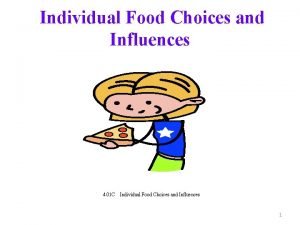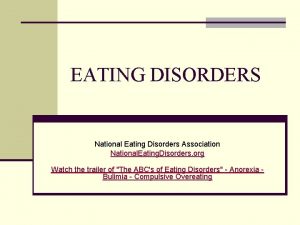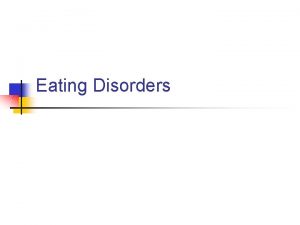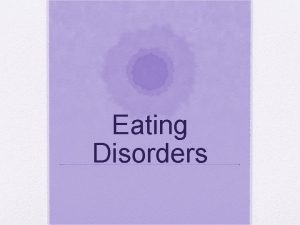Eating Om nom Physiological influences on eating Physiological

















- Slides: 17

Eating Om nom


Physiological influences on eating Physiological (physical) influences on eating mostly relate to hunger. Hunger was also seen as an extension of homeostasis, (food levels low=send hunger signal=eat), although more studies have found additional meanings for hunger. Stomach contractions do coincide with feelings of hunger (often why they are called “hunger pangs”). However, the stomach alone does not cause hunger; rats who had their stomachs removed still felt hungry and ate. Humans who have had their stomachs removed due to cancer or ulcers also still eat and feel hungry.

Chemical and Biological Aspects of Hunger Glucose is the primary source of energy for the human body, in the form of sugar in the blood (“blood sugar”). When our glucose levels drop, we feel hunger. The system for triggering hunger happens in several parts of the body, but most importantly the hypothalamus.


While we’ve talked in the past about how the hypothalamus regulates hunger (and sex, and thirst, and others), there are two particular parts that need examining: The Ventromedial Hypothalamus (VHM)determines when we stop eating. If destroyed, the animal (or human) will eat ravenously, getting fatter and fatter. The Lateral Hypothalamus (LH)determines when we begin eating. If destroyed, the animal rarely eats. Dual-Center Theoryproposes that these two parts work together to maintain a set point, or the body’s balanced and stable weight.


Sensory Influences on Eating The senses, such as sight, smell, taste and mouthfeel all affect how much we want certain foods and how much we like them. Sweet foods often stimulate appetite by triggering the release of insulin, which is the hormone secreted to control blood glucose. Less glucose, more hunger. Wanting and liking foods is modified by experience, with preferences and aversions being shaped by past experiences of pleasure and nausea (remember taste aversion? )


Sociocultural Impacts on Eating People generally eat more when in groups than when alone. This is known as social coactionor social facilitation. However, this is not necessarily the case for females. In many cultures, especially Western ones, eating less food is seen as “feminine”, and this is added onto the current strong interest in “thin” women. Family and cultural practices also shape the way we eat. Did/does anyone had/have a “clean plate” rule in their family? Cultures also have rules about food for occasions (birthday cake, whole turkey) or if they can eat something at all (pork, dogs, insects, etc)


Obesity means being very, even dangerously overweight, a BMI (Body Mass Index) of over 30. Over one third of adults in the United States are considered obese, with 3 out of 4 adult men considered overweight or obese. It makes biological sense for the human body to store excess fat. When our ancestors searched for food, they often had to go long periods without nutritious or fattening foods. They developed “thrifty genes” to help them store and hold on to fat deposits. Now, when food is abundant and exercise not a daily part of life, it is starting to affect us.

Why fat comes easily, and is hard to lose Once the number of fat cells increase, they rarely decrease. Weight-loss diets and procedures generally shrink the size of fat cells, but don’t destroy them entirely. Childhood obesity and adult overeating both lead to the increase of fat cells. Metabolism, or the rate of energy expenditure by the body, varies from person to person, and is generally lower in obese individuals. Weight-loss programs often lower metabolism even further (body thinks it’s starving), making weight loss slow. Society doesn’t help, with food being a reward, and fatty and sugary foods being super available and easy to acquire (fast food, junk food, etc).


Eating Disorders On the other end of the spectrum are eating disorders. These are unhealthy eating behaviors that are clinically defined as psychological disorders, or mental illness. There are multiple types and factors related to eating disorders, but we’ll be discussing two here: Anorexia nervosa and Bulimia nervosa. While seen in both men and women, they are both much more often found in women.

Anorexia Nervosa To be diagnosed with Anorexia Nervosa, a patient typically must: Be exceptionally underweight (less than 85% a “normal” body weight) Have a distorted view of their body size or shape (they think they are fat when they are definitely not) Have an intense fear of gaining weight In postpubertal females, menstruation stops (amenorrhea) There are multiple potential causes for anorexia, including genetic predisposition, an obsession that society prefers thin people especially in women), or thinness in sports. There is some evidence of racial factors as well,

Bulimia nervosa, more commonly known as Bulimia, is an eating disorder characterized by moments of binge eating, or eating large quantities of food, followed either by vomiting or overuse of laxatives (drugs that are meant to ease defecation). Excessive exercise after eating can also be considered bulimia. Like with anorexia, people who suffer from bulimia also have undue concern about their body weight or shape. There is no single simple source of bulimia, with factors coming from genetic, cultural and behavioral backgrounds.
 Synthèse nom propre nom commun
Synthèse nom propre nom commun Physiological influences on food choices include
Physiological influences on food choices include Nom botiquin
Nom botiquin Nom 001
Nom 001 Psalm 115 esv
Psalm 115 esv Haribo slogan allemand
Haribo slogan allemand Nom 030 stps 2006
Nom 030 stps 2006 Nom de professeur
Nom de professeur Difference brocard chevrette
Difference brocard chevrette Yolanda gigliotti
Yolanda gigliotti Derive
Derive Expansion du nom
Expansion du nom Nom dels vents a catalunya
Nom dels vents a catalunya Group nominal
Group nominal Nom d'artiste
Nom d'artiste Mots variable et invariable
Mots variable et invariable Nom du dossier
Nom du dossier Maskil ta naghga
Maskil ta naghga

































